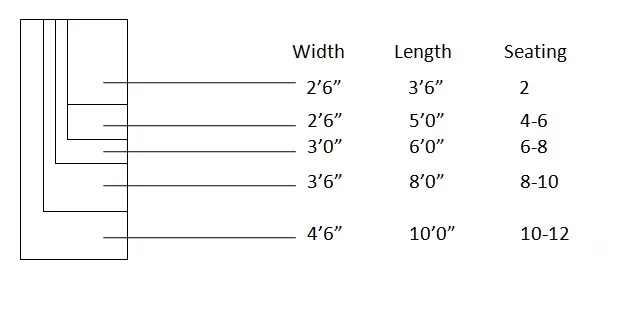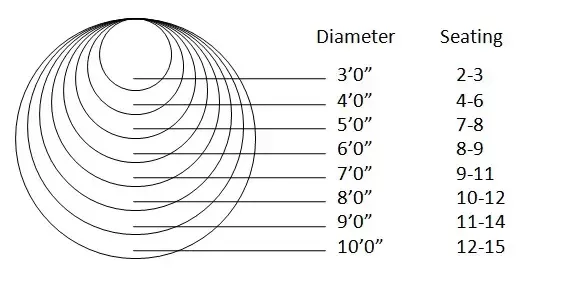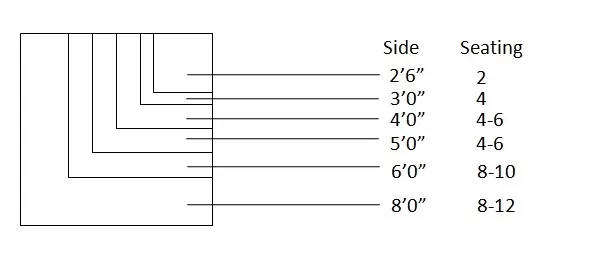Dining Table Sizing
Dining Table Sizing Guidelines
Dining table sizing and style for your space doesn’t need to be a complicated task. You want a table that fits your dining room, accommodates your guests, and matches your personal taste. But how do you know what size to choose? What factors should you consider? And where can you find a custom solid wood table that meets your needs?
In this page, we will answer these questions and more. We will guide you through the process of choosing the perfect dining table size for your space and style. Whether you are looking for a rustic, farmhouse, modern, mid-century modern, contemporary, live edge, or epoxy river table, Taitlin Studio has it all.
Here are the key takeaways from this page:
| Factor | What to do |
|---|---|
| Shape | Choose a shape that suits your space and style. Rectangular tables are the most common and versatile, round tables are cozy and intimate, oval tables are elegant and spacious, and square tables are symmetrical and compact. |
| Dimensions | Measure your dining space and subtract 6 feet from both the length and width to get the maximum recommended size for your table. Adjust the dimensions according to your preferences and needs. |
| Seating capacity | Refer to the standard table dimensions and seating capacity chart below. Add or remove seats as needed. Consider using leaves or extensions, narrower or wider tables, or benches instead of chairs. |
| Clearance | Leave at least 36 inches of space between the table and the wall on all sides and at least 7 inches of space between the chair and the end of the table on each side of the chair. Factor in other furniture and features in your dining space. |
| Style | Choose a style that matches your personal taste and complements your existing decor. Browse Taitlin Studio’s website for inspiration and customization options. |
Dining Table Shapes and Their Advantages
The first factor to consider when choosing a dining table size is the shape of the table. The shape of the table can affect the space efficiency, aesthetics, and functionality of your dining room. Here are the pros and cons of each shape:
- Rectangular tables are the most common and versatile shape for dining tables. They can fit in most spaces and accommodate different numbers of people. They also offer a lot of flexibility in terms of style, as they can range from traditional to contemporary. However, rectangular tables can also make the dining room look narrow or crowded if they are too large or too long.
- Round tables are cozy and intimate shape for dining tables. They are ideal for small spaces and casual gatherings. They also create a sense of equality and harmony among the diners, as everyone can see and talk to each other. However, round tables can also limit the seating capacity and the tableware placement, as they have less surface area and edge space than rectangular tables.
- Oval tables are elegant and spacious shape for dining tables. They combine the benefits of both rectangular and round tables, as they have more surface area and edge space than round tables, but also have softer curves and smoother lines than rectangular tables. They are great for large spaces and formal occasions. However, oval tables can also be difficult to find and expensive to buy, as they are less common and more customized than other shapes.
- Square tables are symmetrical and compact shape for dining tables. They are perfect for small spaces and square rooms, as they create a balanced and proportional look. They are also easy to extend or combine with other tables, as they have equal sides and angles. However, square tables can also be uncomfortable and impractical for larger groups, as they have less legroom and require more space between them.



Dimensions and Seating Capacity
The second factor to consider when choosing a dining table size is the dimensions of the table. The dimensions of the table determine how many people can sit comfortably at the table and how much space the table occupies in your dining room. Here are some steps to follow to find the ideal dimensions for your table:
- Measure your dining space. Use a tape measure to measure the length and width of your dining room or area. Write down the measurements in feet or meters.
- Subtract 6 feet from both measurements. This will give you the maximum recommended size for your table. For example, if your dining space is 12 feet by 10 feet, then your maximum table size should be 6 feet by 4 feet. This will ensure that you have enough clearance around the table for walking and dining comfortably.
- Adjust the dimensions according to your preferences and needs. You can choose a smaller or larger table than the maximum size, depending on your space availability, seating capacity, and style preference. You can also use some tricks to customize your table dimensions, such as adding leaves or extensions, choosing narrower or wider tables, or opting for benches instead of chairs.
Here is a table that shows the standard dining table dimensions and seating capacity for different shapes and numbers of people:
| Shape | Number of people | Dimensions (in feet) | Dimensions (in meters) |
|---|---|---|---|
| Rectangular | 4 | 3 x 5 | 0.9 x 1.5 |
| Rectangular | 6 | 3 x 6 | 0.9 x 1.8 |
| Rectangular | 8 | 4 x 8 | 1.2 x 2.4 |
| Rectangular | 10 | 4 x 10 | 1.2 x 3 |
| Round | 4 | 4 (diameter) | 1.2 (diameter) |
| Round | 6 | 5 (diameter) | 1.5 (diameter) |
| Round | 8 | 6 (diameter) | 1.8 (diameter) |
| Oval | 6 | 3 x 6 | 0.9 x 1.8 |
| Oval | 8 | 4 x 8 | 1.2 x 2.4 |
| Oval | 10 | 4 x 10 | 1.2 x 3 |
| Square | 4 | 4 x 4 | 1.2 x 1.2 |
| Square | 6 | 5 x 5 | 1.5 x 1.5 |
| Square | 8 | 6 x 6 | 1.8 x 1.8 |
You can add or remove seats as needed, depending on the size of your chairs and the comfort level of your guests. For example, you can fit up to six people on a rectangular table that is normally for four people, if you use smaller chairs and place one person at each end of the table.

Dining Table Clearance and Comfort
The third factor to consider when choosing a dining table sizing is the clearance around the table. The clearance is the amount of space between the table and the wall or other furniture and features in your dining room. The clearance affects how comfortable and convenient it is to walk and dine around the table. Here are some tips to follow to ensure enough clearance for your table:
- Leave at least 36 inches of space between the table and the wall on all sides. This will allow you to move around the table easily and pull out the chairs without bumping into anything. If you have a smaller space, you can reduce the clearance to 30 inches, but not less than that.
- Leave at least 7 inches of space between the chair and the end of the table on each side of the chair. This will allow you to sit and stand up comfortably and have enough room for your legs and elbows. If you have a larger table, you can increase the space to 12 inches, but not more than that.
- Factor in other furniture and features in your dining space, such as sideboards, buffets, windows, doors, fireplaces, etc. Make sure that they do not interfere with the clearance or the functionality of the table. For example, if you have a sideboard or a buffet along one wall, you may need to leave more space between the table and that wall to access the storage or serve the food. If you have a window or a door behind one side of the table, you may need to leave more space between the table and that side to open or close them.
